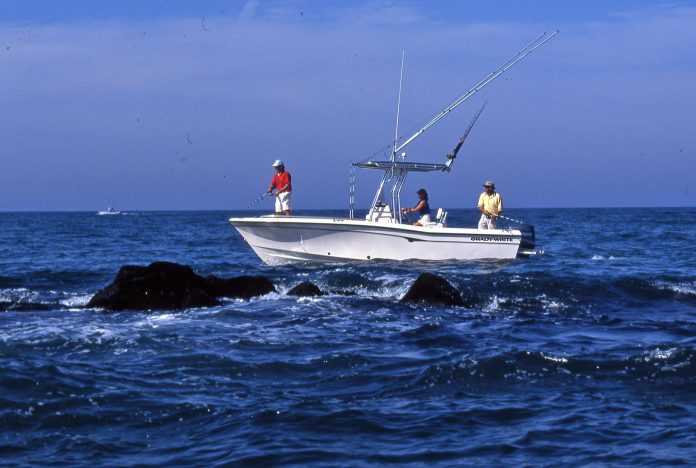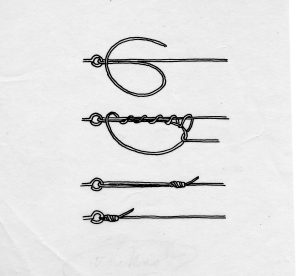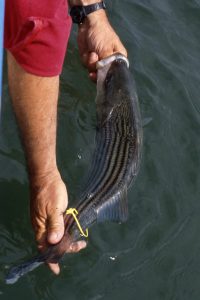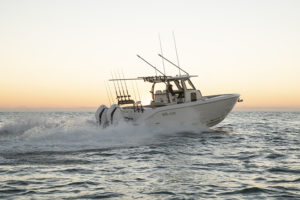
Master these saltwater fishing skills to be better a better angler.
Here are few basic skills a saltwater angler should be reasonably proficient to be successful on the fishing grounds. None of the five below are difficult to master but may help ensure a productive outing.
Tie a Uni-Knot
The uni-knot or uni-knot “system” was popularized years ago by the late Vic Dunaway, longtime editor of Florida Sportsman magazine.
Basically, it’s a single knot that can be used to tie a line to a hook or lure, tie a loop, “snell” a hook, or tie two lines together, even two of different diameters such as a heavy leader to a light line.
This is about the only knot I use (except for the uni-snell, which is easy to tie but can fail) and it’s basically bulletproof. For instructions on tying the various uni-knots, go to YouTube. There are over 27,000 videos on the subject.

Run line through eye of hook, swivel or lure at least 6” and fold to make two parallel lines. Bring end of line back in a circle towards hook.
Make six turns with the tag end around the double line and through the circle. Hold double line at point where it passes through the eye and pull tag to snug up turns.
Now pull standing line to slide knot up against eye. Continue pulling until knot is tight. Trim tag end flush with closest coil of knot. The uni-knot will not slip.
Bleed a Fish to be Kept
If you plan to keep a fish such to take home and eat, you should bleed it right away. If you do this while the fish is still alive, the heart will pump out all the blood so there’s little chance the meat will be tainted by it when you go to cut your fillets from the carcass.
The safest way (assuming you’re right-handed) is to grasp the fish with your left hand by inserting your thumb and index finger into its eye sockets. Then with a very sharp knife, make a single cut down through the throat latch, the narrow fleshy part on its underside between the gills. This will sever a major artery and the blood should come spurting out.
When the fish is dead and has bled out, rinse it off and place it in your cooler. You can fillet or gut it later.
Un-Twist Your Line
Your line can become severely twisted due to trolling lures or drifting deep baits in a strong current, even if you use a swivel. This causes all sorts of problems such as the line lassoing a rod guide, wrapping around the rod tip, or snarling up on the reel.
The easiest remedy is to snip off any snap-swivel or other terminal tackle and pay the twisted portion of line out behind the boat as you idle along. The line will untwist by itself in less than a minute, and you can reel it in and re-connect your lure or hook.
Read a Tide Chart
A pocket-size paper tide table, available for free (or a buck or two) at many marinas and tackle shops, is extremely handy but you need to know how to read it.
First thing to do is find out the time difference between the location for which the table is printed, usually a major port or city, and the locale where you plan to fish. At the back of the pad is a list of towns, bays, and islands and the amount of time you need to add or subtract from the primary times to get the correct time of tides for your area. Simple.
Each day of the year is displayed, and will give you the time of high tide in the morning (midnight to noon), and afternoon (noon to midnight), as well as the height of that tide in feet and tenths of a foot (i.e. 5.3 feet).
Times of low tides in the morning and afternoon are also given, but the “height” in this case is how many feet and tenths they will be above or below the normal low tide mark. If the low is listed at 0.6, low tide will be six-tenths of a foot above normal. Likewise, if it says -1.1, it will be a very low “minus” tide, one and one-tenth foot below normal. Good to know.

Release a Tired Non-Toothy Fish
This works great for fish without sharp teeth, such as striped bass. Remove the hook. Then grasp the fish by the lower jaw with your thumb and forefinger while holding it just ahead of its tail with your other hand. Move the fish slowly back and forth underwater to force water through its gills.
After 10 seconds or so, give a good hard squeeze with the hand holding the tail section. For some reason this will activate the fish, which will squirt forward under its own power and disappear into the depths. Works like a charm.
You can also do the same thing with toothy fish, but in this case use a mechanical lip-gripper on its lower jaw instead of your thumb and forefinger (ouch).


